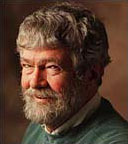 |
→ March 2007 Contents → Camera Corner
|
Camera Corner
Nikon D80 March 2007
|
 |
|
I thought that I had Nikon's DSLR lineup figured out pretty well, ranking the D2X as the F5 of my generation and the D200 as the very capable F100 that came to be my favorite all-around film camera because of its size, weight and great performance.

Is it a pro-level camera? Does it have the "stuff" to make the grade? Good questions!
After about a month with the camera I would say definitely "yes" for most of us but maybe not for some.
If you are a big-time sports shooter and need the 8 fps of the D2X and its 12.4-megapixel sensor and you can't afford a second D2X or D2H, your backup body should probably be the D200.

Let's look at the differences as pointed out so clearly in Mike Stensvold's article on DSLR systems in PC Photo's March-April issue.
"The D80 is a 10.2-megapixel model that combines technology from the D200 with a quick 0.18 second startup time, fast 80ms shutter response, a new high-res image processing engine, and simple operation.

OK, that's an informative list that takes care of most of the statistical stuff but I wanted to see how it handles in the real world.
First off, it feels good in the hands, very well made and surprisingly rugged. Its smaller overall size was not a problem for me and I don't have small hands.
It also seems to be very fast due to the Auto Focus, using an 11-area sensor that is very similar to the D200 and a very short blackout time in the excellent pentaprism viewfinder. That viewfinder is very sharp and bright just like the one in the D200. I'm an eyeglass wearer and I can see the information at the bottom of the screen with no problem.

The D80 has the same large LCD monitor that's on the D200 and the D2X and that makes the picture review and menu reading a breeze. The menu system is also well thought out and offers 32 Custom Menu settings including the option to use the pop up flash in the commander mode to control two groups of SB600s or 800s wirelessly just like its big brothers.
A new feature that I wish was on the D200 is the ability to magnify an image by pushing the Quality button in the playback mode. Keep you finger down and the image magnifies to 25x in eight steps. It's a very quick way to check for closed eyes and weird expressions and an improvement over the two-button system on the D200. The ISO auto setting sounds like it's for amateurs at first but the ability to specify the maximum ISO and minimum shutter speed can be helpful in tricky lighting situations, especially with the improved results at higher ISOs. The new Function button is also a great addition and among many options it gives you a chance to program the camera to show the ISO in the viewfinder or to switch the meter from matrix to spot without having to look at the top screen. Of course, having both of the above visible in the viewfinder like the D200 would have been nice but this is a decent workaround.

One of the reasons the D80 is smaller and lighter is that it uses SD cards rather than the old standby Compact Flash. That means additional expense of new cards and since it is a 10MP camera you sure don't want to buy anything less than a couple of gigs. Fortunately the camera supports the new SD-HC standard and cards are now available up to 8 GB.
You will also need at least one spare battery because even though the camera uses the same EN-EL3 as the D200 it seems that battery life for the D80 is not as great, especially shooting RAW all the time.
The D80 does not have a PC flash connector so you have to use an accessory hot shoe adaptor if you want to plug in your studio strobes.
In short, the D80 seems to be a well-rounded and very reasonably priced addition to almost any Nikon user's camera bag.
© Chick Harrity
Chick Harrity has been playing in photojournalism for 51 years, 34 of them in Washington, D.C. His first staff job was in 1956 with his hometown newspaper, the Reading (Pa.) Times. He moved to New York City with The Associated Press in 1965 and worked in Albany and Chicago for a year each before moving to the AP Washington bureau in 1968. In 1981 he had a chance to try the magazine business at U.S. News and World Report where he stayed for 20 years, being named chief photographer in 1985. On April Fool's Day of 2001 he left U.S. News to move to Northern California where he is now the Photo Coach and contributing photographer for the Calistoga Tribune, a new and thriving 1,250-circulation weekly at the top of the Napa Valley. Highlights along the way include receiving the Associated Press Managing Editors' award for Excellence in Photography; being named the White House News Photographers' Association Photographer of the Year, and being awarded the Leica Medal of Excellence for Photojournalism. His first camera was a Kodak Baby Brownie Special. He worked his way up to a 4x5 Speed Graphic and then down again. He was last seen playing with Nikon D200s and D80s.� |
|
Back to March 2007 Contents
|
|
